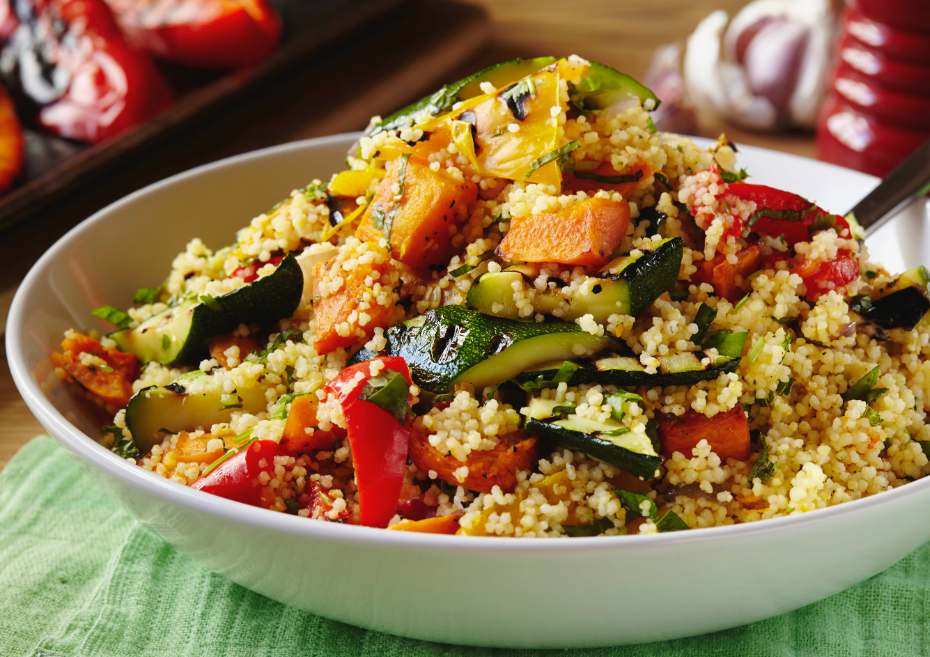
Introduction: In the realm of culinary delights, few dishes balance flavor, nutrition, and ease of preparation quite like the Couscous Salad with Roasted Vegetables. This vibrant dish not only tantalizes the taste buds but also offers a symphony of textures and colors that elevate any mealtime experience. Whether you’re seeking a quick and nutritious lunch option or a delightful side dish for a dinner gathering, this recipe is sure to impress. Packed with wholesome ingredients and bursting with Mediterranean-inspired flavors, it’s a culinary journey that will leave you craving more.
Ingredients:
- 1 cup couscous
- 1 ½ cups vegetable broth
- 1 red bell pepper, diced
- 1 yellow bell pepper, diced
- 1 zucchini, diced
- 1 yellow squash, diced
- 1 red onion, thinly sliced
- 2 tablespoons olive oil
- 2 cloves garlic, minced
- 1 teaspoon dried oregano
- Salt and pepper to taste
- ½ cup cherry tomatoes, halved
- ¼ cup chopped fresh parsley
- ¼ cup crumbled feta cheese (optional)
- Lemon wedges for serving
Instructions:
- Preheat your oven to 400°F (200°C).
- In a large mixing bowl, toss the diced red and yellow bell peppers, zucchini, yellow squash, and red onion with olive oil, minced garlic, dried oregano, salt, and pepper until well coated.
- Spread the vegetables evenly on a baking sheet lined with parchment paper and roast in the preheated oven for 20-25 minutes, or until tender and lightly browned, stirring halfway through cooking.
- While the vegetables are roasting, prepare the couscous. In a medium saucepan, bring the vegetable broth to a boil. Stir in the couscous, cover, and remove from heat. Let it sit for about 5 minutes until all the liquid is absorbed.
- Fluff the couscous with a fork to separate the grains. Transfer it to a large serving bowl.
- Once the roasted vegetables are done, add them to the bowl with the couscous.
- Add the halved cherry tomatoes, chopped parsley, and crumbled feta cheese (if using) to the bowl.
- Gently toss all the ingredients together until evenly combined.
- Taste and adjust the seasoning with salt and pepper if needed.
- Serve the couscous salad with roasted vegetables warm or at room temperature, garnished with lemon wedges for squeezing over the salad just before eating.
Serving Tips:
- Garnish with Fresh Herbs: Before serving, sprinkle some freshly chopped herbs like parsley or basil over the couscous salad for a burst of color and added freshness.
- Add a Protein Boost: For a heartier meal, consider adding grilled chicken, shrimp, or tofu to the salad. The protein addition not only enhances the flavor but also makes the dish more satisfying and nutritious.
- Serve with a Side of Hummus: Pair the couscous salad with roasted vegetables with a side of creamy hummus and warm pita bread. The combination creates a delightful Mediterranean-inspired meal that’s perfect for lunch or dinner.
- Drizzle with Balsamic Glaze: For an extra flavor kick, drizzle some balsamic glaze over the salad just before serving. The sweet and tangy glaze complements the roasted vegetables and couscous beautifully.
- Make it a Complete Meal: Serve the couscous salad alongside a simple green salad or grilled vegetables for a well-rounded and satisfying meal. The combination of flavors and textures will leave your guests impressed and satisfied.
Storage Tips:
- Refrigerate promptly: After preparing the couscous salad with roasted vegetables, allow it to cool to room temperature before transferring it to an airtight container. Place it in the refrigerator promptly to prevent bacterial growth.
- Consume within 3-4 days: While couscous salad can be stored in the refrigerator for several days, it’s best enjoyed within 3-4 days for optimal freshness and flavor.
- Separate wet and dry ingredients: If storing leftovers, consider separating any wet ingredients, such as tomatoes or cucumbers, from the dry ingredients, like couscous and roasted vegetables, to prevent sogginess.
- Reheat gently: When ready to enjoy leftovers, gently reheat the couscous salad in the microwave or on the stovetop. Add a splash of vegetable broth or water to moisten the couscous if it has dried out slightly.
- Refresh with additional ingredients: If the salad seems dry or loses its vibrancy after storage, consider refreshing it by adding a squeeze of lemon juice, a drizzle of olive oil, or a sprinkle of fresh herbs before serving.
By following these serving and storage tips, you can ensure that your couscous salad with roasted vegetables remains flavorful, fresh, and enjoyable for days to come. Whether serving it as a standalone dish or as part of a larger meal, this versatile recipe is bound to impress both family and guests alike.
Variations:
- Mediterranean-Inspired Twist:
- Substitute the vegetable broth with chicken or vegetable stock for added depth of flavor in the couscous.
- Incorporate olives, artichoke hearts, and sun-dried tomatoes for a Mediterranean flair.
- Top the salad with crumbled goat cheese and toasted pine nuts for a rich and creamy texture.
- Spice it Up with Harissa:
- Add a teaspoon or two of harissa paste to the roasted vegetable marinade for a spicy kick.
- Mix in chopped fresh mint and cilantro for a refreshing contrast to the heat.
- Serve the couscous salad with a dollop of Greek yogurt or tzatziki sauce to cool down the palate.
- Grilled Vegetable Variation:
- Instead of roasting the vegetables, grill them for a smoky flavor profile.
- Brush the vegetables with olive oil and season with your favorite herbs and spices before grilling.
- Char the vegetables slightly to enhance their natural sweetness and add depth to the dish.
- Protein-Packed Options:
- Incorporate cooked chickpeas or white beans into the salad for added protein and fiber.
- Toss in diced grilled tofu or tempeh for a plant-based protein option.
- For meat lovers, add sliced grilled steak or lamb for a hearty and satisfying meal.
- Seasonal Variations:
- Customize the salad based on seasonal produce availability. For example, use asparagus and snap peas in the spring, or butternut squash and Brussels sprouts in the fall.
- Experiment with different herbs and spices to complement the seasonal flavors, such as thyme and sage in the fall or basil and mint in the summer.
- Asian-Inspired Fusion:
- Swap the Mediterranean flavors for Asian-inspired ingredients like soy sauce, sesame oil, and rice vinegar.
- Add diced tofu or edamame for a protein boost and toss in shredded carrots and snow peas for a crunchy texture.
- Garnish the salad with sliced green onions, toasted sesame seeds, and a drizzle of sriracha mayo for a bold and flavorful finish.
By exploring these creative variations, you can transform the classic couscous salad with roasted vegetables into exciting new dishes that cater to different tastes and preferences. Whether you prefer bold and spicy flavors or light and refreshing combinations, there’s a variation to suit every palate and occasion.
FAQs (Frequently Asked Questions):
- Can I make this couscous salad ahead of time?
- Absolutely! This couscous salad with roasted vegetables is a great make-ahead dish. Simply prepare it as directed and store it in an airtight container in the refrigerator for up to 3-4 days. Just be sure to give it a good stir before serving to redistribute the flavors.
- Is couscous gluten-free?
- Traditional couscous is made from wheat, so it contains gluten. However, there are gluten-free alternatives available, such as quinoa or rice couscous, which can be used in this recipe as a substitute.
- Can I freeze leftover couscous salad?
- While you can technically freeze couscous salad, it’s not recommended, as the texture of the vegetables and couscous may become mushy when thawed. It’s best to enjoy the salad fresh or store it in the refrigerator for a few days.
- How can I make this salad more filling?
- To make the salad more filling, consider adding protein-rich ingredients like grilled chicken, shrimp, tofu, or beans. These additions not only enhance the nutritional value of the dish but also make it more satisfying and hearty.
- Can I customize the vegetables in this salad?
- Absolutely! Feel free to customize the vegetables based on your preferences or what’s in season. You can add or substitute any vegetables you like, such as mushrooms, eggplant, carrots, or spinach.
- Is this salad suitable for vegans?
- Yes, this couscous salad with roasted vegetables can easily be made vegan by omitting the optional feta cheese or substituting it with a plant-based alternative. Ensure that the vegetable broth used is also vegan-friendly.
- How do I adjust the seasoning if I’m watching my sodium intake?
- If you’re watching your sodium intake, you can reduce or omit the salt in the recipe. You can also use low-sodium vegetable broth and season the salad with herbs, spices, and lemon juice to enhance the flavor without adding extra salt.
- Can I serve this salad as a main dish?
- Absolutely! This couscous salad with roasted vegetables is hearty and flavorful enough to be served as a main dish, especially when paired with protein-rich additions like grilled chicken or tofu.
By addressing these common questions, you can provide helpful information and guidance to readers who may have inquiries about the couscous salad with roasted vegetables recipe. Whether they’re looking for storage tips, dietary considerations, or customization options, these FAQs offer valuable insights to enhance their cooking experience.
In conclusion, the Couscous Salad with Roasted Vegetables is a versatile and satisfying dish that combines wholesome ingredients with vibrant flavors and textures. Whether enjoyed as a light lunch, a hearty dinner, or a flavorful side dish, this recipe offers endless possibilities for customization and creativity. From Mediterranean-inspired twists to Asian fusion variations, there’s something for every palate and occasion.
With its simple preparation and make-ahead convenience, this salad is perfect for busy weeknights, meal prep sessions, or entertaining guests. By following the serving and storage tips provided, you can ensure that your couscous salad remains fresh, flavorful, and enjoyable for days to come.
